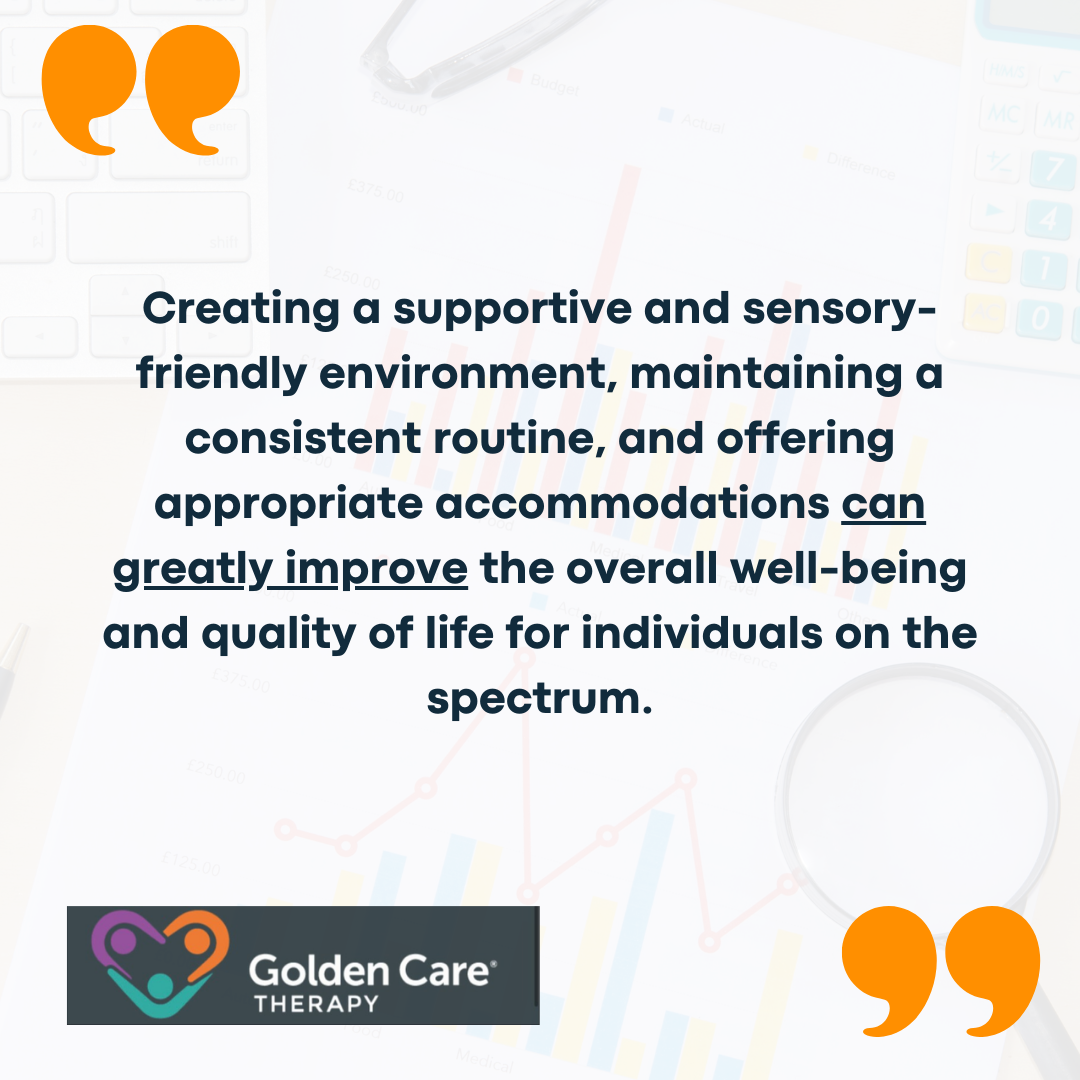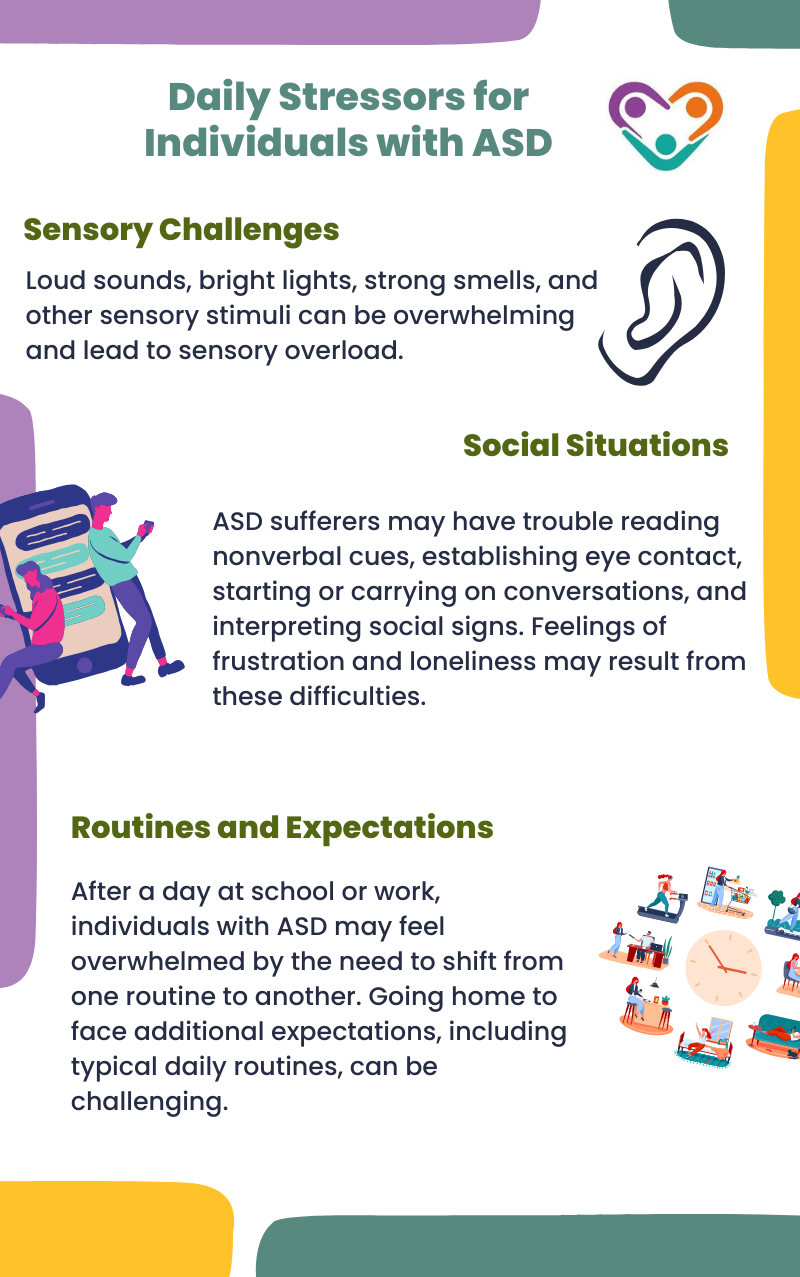
Table of Contents
To effectively support individuals with autism spectrum disorder (ASD), it is essential to understand the triggers that can lead to meltdowns or heightened anxiety. Autism triggers can vary from person to person, but there are some common factors that can impact individuals on the spectrum. This section explores three key triggers: routine disruptions, sensory sensitivity, and new environments.
- Routine Disruptions
For many individuals with autism, routine is crucial in providing a sense of structure and familiarity. Changes in routine can be a trigger for autistic meltdowns, as many individuals feel more comfortable when sticking to a routine. Disruptions to their daily schedule or unexpected changes can lead to stress and potential meltdowns.
- Sensory Sensitivity
Sensory sensitivity is a common characteristic among individuals on the autism spectrum. Many individuals with autism experience heightened sensitivity to sensory input, such as loud sounds, bright lights, or crowded environments. These sensory stimuli can be overwhelming and lead to anxiety or meltdowns.
- New Environments
Feeling overwhelmed in a new environment can be a trigger for meltdowns in individuals with autism. New environments can introduce changes in routine, unfamiliar people, and increased anxiety due to communication challenges. Preparing them in advance by providing visual schedules, social stories, or virtual tours can help alleviate anxiety and make the transition smoother.
By understanding these autism triggers, parents, caregivers, and educators can better anticipate and manage potential meltdowns or anxiety in individuals with autism spectrum disorder. Creating a supportive and sensory-friendly environment, maintaining a consistent routine, and offering appropriate accommodations can greatly improve the quality of life for people on the spectrum.
Common Triggers for Meltdowns
Meltdowns can be distressing for individuals with autism and their loved ones. Understanding the common triggers that can lead to meltdowns is crucial in providing the necessary support and creating a more accommodating environment. Here are three common triggers for meltdowns in individuals with autism:
Overwhelming Public Places
Public places that are crowded or have excessive sensory stimulation can be overwhelming for individuals with autism. Malls, train stations, theaters, and other busy environments may trigger meltdowns due to the high levels of noise, bright lights, and unfamiliar people. The sensory sensitivity experienced by many individuals on the autism spectrum can make these environments particularly challenging to navigate.
Unmet Basic Needs
Unmet basic needs can exacerbate the vulnerability to triggers and increase the likelihood of meltdowns in individuals with autism. Factors such as tiredness, hunger, thirst, and too much social interaction without breaks can contribute to feelings of distress and frustration. Providing regular meals, rest breaks, and opportunities for hydration can help reduce the likelihood of meltdowns.
Unstructured Time
The lack of clear boundaries or specific activities can create anxiety and a sense of uncertainty. Without a structured routine or activity, individuals with autism may struggle to manage their time effectively and become overwhelmed. Providing structure and clear expectations during unstructured periods can help individuals with autism feel more secure and reduce the likelihood of meltdowns.
Daily Stressors for Individuals with ASD
Living with ASD can present unique challenges and stressors for individuals on a daily basis. Understanding these daily stressors is crucial for providing appropriate support and intervention. In this section, we will explore three common stressors for individuals with ASD: sensory challenges, social situations, and routines and expectations.
Sensory Challenges
Sensory sensitivity is a common characteristic among individuals on the autism spectrum. Loud sounds, bright lights, strong smells, and other sensory stimuli can be overwhelming and lead to sensory overload. This sensory overload can trigger meltdowns and other challenging behaviors.
Social Situations
Social situations can be especially difficult for people with ASD. Social anxiety and stress can be brought on by difficulties with social interaction and communication. ASD sufferers may have trouble reading nonverbal cues, establishing eye contact, starting or carrying on conversations, and interpreting social signs. Feelings of frustration and loneliness may result from these difficulties.
Routines and Expectations
Changes in routines or unexpected events can cause anxiety and distress. After a day at school or work, individuals with ASD may feel overwhelmed by the need to shift from one routine to another. Going home to face additional expectations, including typical daily routines, can be challenging. Providing clear communication, visual schedules, and gradual transitions can help them manage their daily routines more effectively.
Signs of Anxiety in Individuals with ASD
Anxiety is a common experience for individuals ASD. Recognizing the signs of anxiety in individuals with ASD is crucial for understanding their needs and providing appropriate support. Here, we will explore the manifestations of anxiety and unique anxiety behaviors commonly observed in these individuals.
Manifestations of Anxiety
Those with ASD may display various manifestations of anxiety. Each person may have a unique way of showing anxiety, which can make it challenging to identify. Some common manifestations include:
- Constant questioning: Individuals may ask repetitive or constant questions as a way to seek reassurance or obtain a sense of control.
- Constant interruptions: Anxiety can lead to difficulties in maintaining attention or waiting for their turn to speak, resulting in frequent interruptions during conversations or activities.
- Retreating or running away: When overwhelmed by anxiety, individuals may feel the need to escape from the situation by retreating to a safe space or attempting to run away.
- Rudeness or provoking behavior: Anxiety can sometimes manifest as challenging behavior, such as being rude or provoking others. This behavior may be a defense mechanism to cope with overwhelming emotions.
It is important to note that these manifestations of anxiety can vary widely among these individuals. Understanding one’s unique anxiety behaviors can help caregivers and educators provide appropriate support and interventions.
Unique Anxiety Behaviors
In addition to the common manifestations mentioned above, people with ASD may exhibit unique anxiety behaviors. These behaviors can serve as indicators of distress or anxiety. Some examples include:
- Biting fingernails: Some individuals may engage in self-stimulatory behaviors, such as biting their fingernails, as a way to cope with anxiety or nervousness.
- Talking excessively: Anxiety may lead to an increase in verbal output, with individuals talking a lot or rapidly. This behavior may be a result of an attempt to regulate their emotions or communicate their anxiety.
- Physical signs: These individuals may exhibit physical signs of anxiety, such as rocking back and forth, flapping their hands, or becoming very still. These physical behaviors can provide visible cues of their internal distress.
By understanding the signs and being proactive in providing support, it is possible to help individuals manage their anxiety and prevent or minimize meltdowns. Doing so will also help us in creating a supportive environment that promotes their well-being and helps them navigate daily challenges with greater ease.
Long-term Stressors
Long-term stressors can also contribute to meltdowns in individuals with autism. These stressors can include factors such as sensory overload, social challenges, and regular daily stressors. Over time, the accumulation of stress can make individuals more susceptible to experiencing meltdowns, even in seemingly small or insignificant situations.
Identifying and addressing long-term stressors is essential for managing meltdowns. This may involve implementing strategies to reduce sensory overload, providing social support and resources, and creating a structured and predictable environment that minimizes daily stressors. It is important to recognize that each individual with autism is unique, and what may be stressful for one person may not be the same for another.
The Takeaway
Preventing meltdowns in people with ASD is a crucial aspect of managing their well-being and promoting a positive environment. By anticipating meltdowns and implementing effective strategies for prevention, caregivers and individuals can work together to create a more supportive and soothing environment.
The steps may involve a combination of removing triggers and helping the individual utilize calming strategies. Distraction and diversion techniques can also be effective in redirecting the individual’s attention and preventing the meltdown from escalating. This can include engaging the individual in a preferred activity, offering a sensory toy or tool to focus on, or redirecting their attention to a different task.
Creating a calm and structured environment is essential in preventing meltdowns. By providing a sense of predictability, individuals with ASD may feel more secure and less prone to meltdowns. Additionally, some individuals may benefit from listening to calming music or engaging in deep breathing exercises to help regulate their emotions.
It’s important to note that not all meltdowns can be prevented, and each individual may have unique triggers and needs. Therefore, it is crucial to work closely with professionals, such as therapists or doctors, to develop personalized strategies for preventing meltdowns based on the specific needs of the individual.
Sources:
- https://www.iidc.indiana.edu/irca/articles/what-triggers-anxiety-for-an-individual-with-asd.html
- https://www.myautism.org/informational-kits/what-causes-a-meltdown-amp-how-to-prevent-them
- https://themighty.com/topic/autism-spectrum-disorder/autistic-meltdowns-triggers/
- Autism Routine Disruption in Adults: Coping Tips - July 16, 2024
- Autism and Obsession: An Overview - July 16, 2024
- Autism and Taking Clothes Off: Management Tips - July 16, 2024



